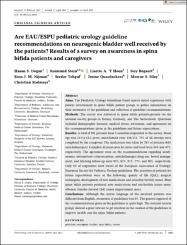| dc.contributor.author | Doğan, Hasan Serkan | |
| dc.contributor.author | Stein, Raimund | |
| dc.contributor.author | Hoen, Lisette A. 'T | |
| dc.contributor.author | Bogaert, Guy | |
| dc.contributor.author | Nijman, Rien J. M. | |
| dc.contributor.author | Tekgül, Serdar | |
| dc.contributor.author | Quaedackers, Josine | |
| dc.contributor.author | Sılay, Mesrur Selçuk | |
| dc.contributor.author | Radmayr, Christian | |
| dc.date.accessioned | 2023-11-29T14:10:07Z | |
| dc.date.available | 2023-11-29T14:10:07Z | |
| dc.date.issued | 2019 | en_US |
| dc.identifier.issn | 0733-2467 | |
| dc.identifier.issn | 1520-6777 | |
| dc.identifier.uri | https://hdl.handle.net/11363/6568 | |
| dc.description.abstract | Aims: The Paediatric Urology Guidelines Panel reports initial experience with
patient involvement in spina bifida patient groups to gather information on
their awareness of the guidelines and reflection of guideline recommendations.
Methods: The survey was delivered to spina bifida patients/parents via the
national society groups in Turkey, Germany, and The Netherlands. Questions
included demographic features, medical status, awareness, and agreement on
the recommendations given in the guidelines and future expectations.
Results: A total of 291 patients from 3 countries responded to the survey. Mean
age was 13.9 ± 12.2 years, male/female ratio 138/151, 75% of all surveys were
completed by the caregivers. The medication was taken by 78% of patients (64%
anticholinergics). Complete dryness rates for urine and stool were 24% and 47%,
respectively. The agreement rates on the recommendations regarding urodynamics, intermittent catheterization, anticholinergics drug use, bowel management, and life‐long follow‐up were 97%, 82%, 91%, 77%, and 98%, respectively.
Only 8% of responders were aware of the European Association of Urology/
European Society for Pediatric Urology guidelines. The priorities of patients for
future expectations were as the following: quality of life (QoL), surgical
techniques, development of new medications and sexuality/fertility issues. Male
spina bifida patients preferred new medications and sex/fertility issues more,
whereas females favored QoL issues improvement more.
Conclusions: Although the native language of the involved patients was
different from English, awareness of guidelines was 8%. The general approval of
the recommendations given in the guidelines is quite high. The national society
groups showed a great interest to get involved in the creation of the guidelines to
improve health care for spina bifida patients. | en_US |
| dc.language.iso | eng | en_US |
| dc.publisher | WILEY, 111 RIVER ST, HOBOKEN 07030-5774, NJ | en_US |
| dc.relation.isversionof | 10.1002/nau.24024 | en_US |
| dc.rights | info:eu-repo/semantics/openAccess | en_US |
| dc.subject | guideline | en_US |
| dc.subject | neurogenic bladder | en_US |
| dc.subject | spina bifida | en_US |
| dc.subject | survey | en_US |
| dc.title | Are EAU/ESPU pediatric urology guideline recommendations on neurogenic bladder well received by the patients? Results of a survey on awareness in spina bifida patients and caregivers | en_US |
| dc.type | article | en_US |
| dc.relation.ispartof | Neurourology and Urodynamics | en_US |
| dc.department | Sağlık Bilimleri Fakültesi | en_US |
| dc.authorid | https://orcid.org/0000-0002-3217-5089 | en_US |
| dc.authorid | https://orcid.org/0000-0002-7873-6216 | en_US |
| dc.identifier.volume | 38 | en_US |
| dc.identifier.issue | 6 | en_US |
| dc.identifier.startpage | 1625 | en_US |
| dc.identifier.endpage | 1631 | en_US |
| dc.relation.publicationcategory | Makale - Uluslararası Hakemli Dergi - Kurum Öğretim Elemanı | en_US |
| dc.contributor.institutionauthor | Sılay, Mesrur Selçuk | |

















